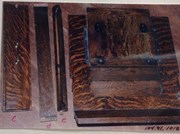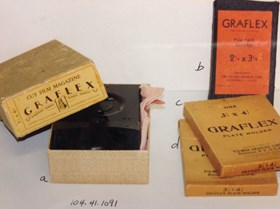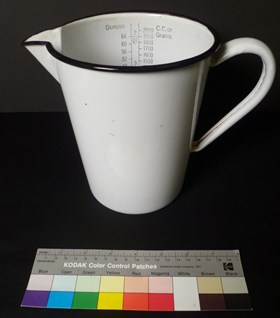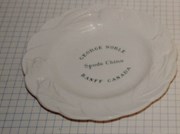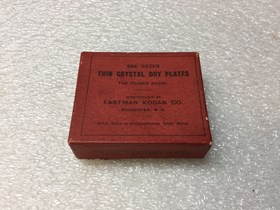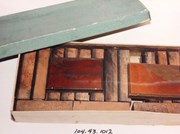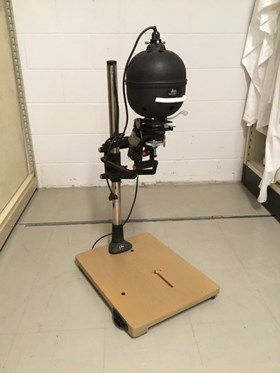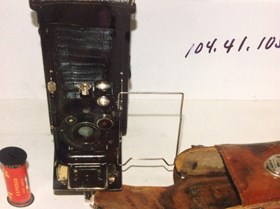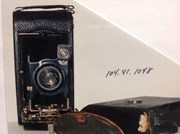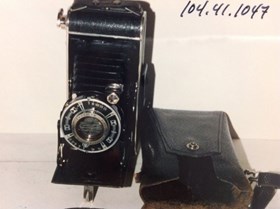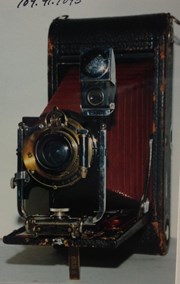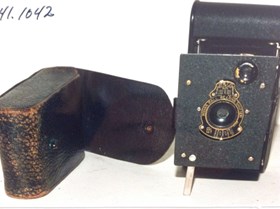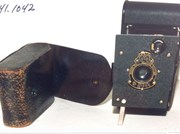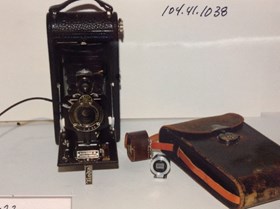Narrow Results By
Copy Stand Parts
https://archives.whyte.org/en/permalink/artifact104.41.1018%20a-e
- Date
- 1910 – 1930
- Material
- wood, metal
- Catalogue Number
- 104.41.1018 a-e
- Description
- 5 pieces dark oak; photographic stand parts; solid wood 2.0 cm thick; (a) 56.0x56.0 with a 53.5x13.0 ledge at an angle; a 5.0 bar across back; inset into front is (b) 35.5x35.5, has 4 metal'shoes' 2 round 4.5 diameter and 2 square, open one side; slides under 2metal bars on (a); (c) 13.0x56…
1 image
- Title
- Copy Stand Parts
- Date
- 1910 – 1930
- Material
- wood, metal
- Description
- 5 pieces dark oak; photographic stand parts; solid wood 2.0 cm thick; (a) 56.0x56.0 with a 53.5x13.0 ledge at an angle; a 5.0 bar across back; inset into front is (b) 35.5x35.5, has 4 metal'shoes' 2 round 4.5 diameter and 2 square, open one side; slides under 2metal bars on (a); (c) 13.0x56.0 part of drawer, with lock one end and brasshandle centered;(d) 7.6x63.0, 2 holes each end; (e) 58.0x5.0; wedge shaped with nipple one end.
- Subject
- photography
- Credit
- Gift of Unknown, 1968
- Catalogue Number
- 104.41.1018 a-e
Images
This material is presented as originally created; it may contain outdated cultural descriptions and
potentially offensive content.
Read more.
- Date
- 1920 – 1940
- Material
- metal; skin; glass; fibre; paper; wood
- Catalogue Number
- 104.41.1091 a-d
- Description
- Graflex cut film magazine 3 1/4 x 4 1/4 (a), marked “GRAFLEX CUT FILM MAGAZINE. PAT. SEPT. 7, 1920. OTHER PATENTS PENDING. MADE IN U.S.A. BY EASTMAN KODAK CO. FOLMER & SCHWING DEPT. ROCHESTER, N.Y., in original labeled cardboard box. “GRAFLEX FILM PACK ADAPTER 2 1/4 x 3 1/4, Manufactured by THE FOL…
1 image
- Title
- Cut-Film Holder
- Date
- 1920 – 1940
- Material
- metal; skin; glass; fibre; paper; wood
- Dimensions
- 5.5 x 12.0 x 17.5 cm
- Description
- Graflex cut film magazine 3 1/4 x 4 1/4 (a), marked “GRAFLEX CUT FILM MAGAZINE. PAT. SEPT. 7, 1920. OTHER PATENTS PENDING. MADE IN U.S.A. BY EASTMAN KODAK CO. FOLMER & SCHWING DEPT. ROCHESTER, N.Y., in original labeled cardboard box. “GRAFLEX FILM PACK ADAPTER 2 1/4 x 3 1/4, Manufactured by THE FOLMER GRAFLEX CORP., ROCHESTER, N.Y., U.S.A.” (b) in original black cardboard box with orange printed label. Two plate holders (c,d) marked “3 1/4 x 4 1/4 GRAFLEX PLATE PAT. JUNE 7, 1927. FOLMER GRAFLEX CORP. U.S.A.” in original labeled cardboard boxes.
- Subject
- photography
- Vaux family
- Credit
- Gift of Molly Vaux, New York, USA, 1999
- Catalogue Number
- 104.41.1091 a-d
Images
This material is presented as originally created; it may contain outdated cultural descriptions and
potentially offensive content.
Read more.
Developer Liquid Measure
https://archives.whyte.org/en/permalink/artifact104.41.1159
- Date
- 1925
- Material
- enamel; paper; adhesive
- Catalogue Number
- 104.41.1159
- Description
- A white enamel 64 ounce cylindrical measuring jug with black trim and black handle. The scale is located on the inside of the measuring jug and contains both ounces and cubic centimeters or milliliters symbolized by “c.c.” The front of the measuring jug has a worn oval-shaped sticker. A single blu…
1 image
- Title
- Developer Liquid Measure
- Date
- 1925
- Material
- enamel; paper; adhesive
- Dimensions
- 20.5 x 21.0 x 12.8 cm
- Description
- A white enamel 64 ounce cylindrical measuring jug with black trim and black handle. The scale is located on the inside of the measuring jug and contains both ounces and cubic centimeters or milliliters symbolized by “c.c.” The front of the measuring jug has a worn oval-shaped sticker. A single blue line forms a border that separates the inside of the circle from the outside; the inside of the circle has the company name “FISHER” while the outside has the information “FISHER SCIENTIFIC CO. LTD” “MONTREAL CANADA.”
- Subject
- dark room
- photography
- Nick Morant
- Credit
- Gift of Nicholas Morant, Banff, 2006
- Catalogue Number
- 104.41.1159
Images
This material is presented as originally created; it may contain outdated cultural descriptions and
potentially offensive content.
Read more.
Developer Liquid Measure
https://archives.whyte.org/en/permalink/artifact104.41.1160
- Date
- 1925
- Material
- enamel
- Catalogue Number
- 104.41.1160
- Description
- A white enamel 64 ounce cylindrical measuring jug with black trim and black handle. The scale is located on the inside of the measuring jug and contains both ounces and cubic centimeters or milliliters symbolized by “c.c.” The front of the measuring jug has a worn oval-shaped sticker. A single blu…
1 image
- Title
- Developer Liquid Measure
- Date
- 1925
- Material
- enamel
- Dimensions
- 18.5 x 24.5 x 15.2 cm
- Description
- A white enamel 64 ounce cylindrical measuring jug with black trim and black handle. The scale is located on the inside of the measuring jug and contains both ounces and cubic centimeters or milliliters symbolized by “c.c.” The front of the measuring jug has a worn oval-shaped sticker. A single blue line forms a border that separates the inside of the circle from the outside; the inside of the circle has the company name “FISHER” while the outside has the information “FISHER SCIENTIFIC CO. LTD” “MONTREAL CANADA.”
- Subject
- dark room
- photography
- Nick Morant
- Credit
- Gift of Nicholas Morant, Banff, 2006
- Catalogue Number
- 104.41.1160
Images
This material is presented as originally created; it may contain outdated cultural descriptions and
potentially offensive content.
Read more.
- Date
- 1920 – 1940
- Material
- ceramic
- Catalogue Number
- 104.20.1104
- Description
- Small white china plate with a scalloped edge and three tulips and leaves in relief on the rim. The plate has green printing on the face: “George Noble Spode China Banff, Canada” and the Copeland Spode trademark on the bottom.
1 image
- Title
- Dish
- Date
- 1920 – 1940
- Material
- ceramic
- Description
- Small white china plate with a scalloped edge and three tulips and leaves in relief on the rim. The plate has green printing on the face: “George Noble Spode China Banff, Canada” and the Copeland Spode trademark on the bottom.
- Credit
- Purchased from Phyllis Cain, Banff, 1988
- Catalogue Number
- 104.20.1104
Images
This material is presented as originally created; it may contain outdated cultural descriptions and
potentially offensive content.
Read more.
- Date
- 1920 – 1940
- Material
- cardboard; paper; glass;
- Catalogue Number
- 104.41.0220
- Description
- Box of one dozen Thin Crystal Dry Plates for a Pocket Kodak camera. The box’s seal has been broken - inside are alternating layers of thin black paper and the glass plates, which are fogged.Dry plate, or the gelatin process, was invented by Dr. Richard L. Maddox in 1871 and replaced the more time-c…
1 image
- Title
- Dry Plates
- Date
- 1920 – 1940
- Material
- cardboard; paper; glass;
- Dimensions
- 1.9 x 6.0 x 5.1 cm
- Description
- Box of one dozen Thin Crystal Dry Plates for a Pocket Kodak camera. The box’s seal has been broken - inside are alternating layers of thin black paper and the glass plates, which are fogged.Dry plate, or the gelatin process, was invented by Dr. Richard L. Maddox in 1871 and replaced the more time-consuming wet plate, or collodion process, which required active wet chemicals to be prepared in mobile dark rooms. The dry plate process underwent several adaptations throughout the 1870s and, in 1879, George Eastman developed a method of applying the emulsion layer to glass in a factory setting, simultaneously creating what came to be known as the Eastman Kodak Co. and bringing down the cost of photography so as to be accessible to the masses.
- Subject
- photography
- photographic equipment
- Credit
- Gift of Catharine Robb Whyte, O. C., Banff, 1979
- Catalogue Number
- 104.41.0220
Images
This material is presented as originally created; it may contain outdated cultural descriptions and
potentially offensive content.
Read more.
Engraving Plate
https://archives.whyte.org/en/permalink/artifact104.43.1012
- Date
- 1915 – 1930
- Material
- metal; wood
- Catalogue Number
- 104.43.1012
- Description
- 16 copper engraving plates mounted on wooden blocks in cardboard box marked in pencil: “Copper negatives of Camping trips CBH.” 10 of the plates have images of camping, mountain scenes, trail riding, etc. 6 of the plates have images which appear to be from the Middle East - desert scenes, camels, e…
1 image
- Title
- Engraving Plate
- Date
- 1915 – 1930
- Material
- metal; wood
- Dimensions
- 2.5 x 6.0 x 10.0 cm
- Description
- 16 copper engraving plates mounted on wooden blocks in cardboard box marked in pencil: “Copper negatives of Camping trips CBH.” 10 of the plates have images of camping, mountain scenes, trail riding, etc. 6 of the plates have images which appear to be from the Middle East - desert scenes, camels, etc. Some blocks are labeled “Hinman” or “Mrs. Hinman” and two are labeled “Smith.”These items were transferred to the Archives by SS in May/June 2014.
- Credit
- Gift of Molly Vaux, New York, USA, 1999
- Catalogue Number
- 104.43.1012
Images
This material is presented as originally created; it may contain outdated cultural descriptions and
potentially offensive content.
Read more.
- Date
- 1920 – 1945
- Material
- wood; metal; glass; plastic;
- Catalogue Number
- 104.41.0170
- Description
- Black and silver metal Leitz negative enlarger mounted on a wooden base. The enlarger consists of an almost round light housing with the power cord coming out from the top - immediately below the globe is a series of plates containing the various filters and lenses, as well as the mounting gear tha…
1 image
- Title
- Enlarger
- Date
- 1920 – 1945
- Material
- wood; metal; glass; plastic;
- Dimensions
- 95.8 x 41.7 x 51.9 cm
- Description
- Black and silver metal Leitz negative enlarger mounted on a wooden base. The enlarger consists of an almost round light housing with the power cord coming out from the top - immediately below the globe is a series of plates containing the various filters and lenses, as well as the mounting gear that attaches the enlarger to the silver metal stand. The enlarger is attached to the stand with adjustable arms and a spring that can be released with a small lever so that the device can be moved closer to or further away from the wooden base.
- Credit
- Gift of Nicholas Morant, Banff, 2006
- Catalogue Number
- 104.41.0170
Images
This material is presented as originally created; it may contain outdated cultural descriptions and
potentially offensive content.
Read more.
Film Magazine Case
https://archives.whyte.org/en/permalink/artifact104.41.0085
- Date
- 1920 – 1940
- Material
- leather; fabric; metal; paper
- Catalogue Number
- 104.41.0085
- Description
- Black hard-sided leather case with a hinged lid that clasps shut with two metal clasps on either side of a metal hinge lock and metal corner braces. There are two metal bases attached to the lid where a handle may have been attached, handle missing. Faded leather strap is attached with metal clasps…
1 image
- Title
- Film Magazine Case
- Date
- 1920 – 1940
- Material
- leather; fabric; metal; paper
- Dimensions
- 27.7 x 34.1 cm
- Description
- Black hard-sided leather case with a hinged lid that clasps shut with two metal clasps on either side of a metal hinge lock and metal corner braces. There are two metal bases attached to the lid where a handle may have been attached, handle missing. Faded leather strap is attached with metal clasps to rings mounted on both short sides of the case. There is a small square sticker, possibly a travel marker from Mexico, on the left-hand short side under the clasp. In the middle of the lid is a rectangular Canadian Pacific label that has “Film Case” written in black ink and a stamped “PROPERTY OF NICHOLAS MORANT BANFF, ALBERTA” in blue ink. Attached with a short piece of white string to the right-hand carry strap clasp is a paper Canadian Pacific tag that has something written in black ink that is badly damaged by water. A cataloguer tag is also attached to that clasp with “MORANT COLLECTION (film magazines)” written on it in black ink.The interior of the box is lined with a dark red fabric, possibly velvet and is divided into two compartments, the left one slightly larger than the right. The interior of the lid is also divided into two compartments that close off with snaps - small leather pull tabs allowed the compartments to be accessed. There are no manufacturer’s marks on the case. Found inside are three different film magazines.
- Credit
- Gift of Nicholas Morant, Banff, 2006
- Catalogue Number
- 104.41.0085
Images
This material is presented as originally created; it may contain outdated cultural descriptions and
potentially offensive content.
Read more.
- Date
- 1920 – 1940
- Material
- metal; leather; plastic; celluloid
- Catalogue Number
- 104.41.0086 a-c
- Description
- Three black metal and leather “GRAFLEX CUT FILM MAGAZINE,” used to store individual celluloid negatives mounted into individual sleeves housed inside the main body. Access to the main body is possible by removing the the thin back panel with a leather strap that slides up alongside the leather bag …
1 image
- Title
- Film Magazines
- Date
- 1920 – 1940
- Material
- metal; leather; plastic; celluloid
- Dimensions
- 11.0 x 3.5 x 6.5 cm
- Description
- Three black metal and leather “GRAFLEX CUT FILM MAGAZINE,” used to store individual celluloid negatives mounted into individual sleeves housed inside the main body. Access to the main body is possible by removing the the thin back panel with a leather strap that slides up alongside the leather bag as well by pressing a button on the edge opposite the leather bag, allowing the front panel to pop open. On the front panel that can pop off is a small peephole accessible by a spring-hinged cover. Two of the magazines, marked with a red and a white strip of fabric, have the front panels taped closed with a small piece of masking tape.The three magazines are meant for different kinds of film. The one marked with a small strip of green fabric is meant for “KODAK EXTACOLOR Professional Type S (Short Exposure),” the one marked with the red fabric is meant for “KODAK EKTACHROME Film 6116, Type B (Process E-3),” and the one marked with the white fabric is meant for “KODAK TRI-X PAN SHEET FILM (ESTAR Thick Base).” The individual slides housed inside the magazine with the green fabric may have unprocessed fogged negatives still in them.
- Subject
- Nicholas Morant
- photography
- Kodak
- film photography
- photo developing
- Canadian Pacific Railway
- Credit
- Gift of Nicholas Morant, Banff, 2006
- Catalogue Number
- 104.41.0086 a-c
Images
This material is presented as originally created; it may contain outdated cultural descriptions and
potentially offensive content.
Read more.
Film Strip Projector
https://archives.whyte.org/en/permalink/artifact105.05.1015
- Date
- c. 1930
- Material
- metal; paper; glass
- Catalogue Number
- 105.05.1015
- Description
- 35 mm film strip projector and case. Simple design projector having rectangular metal base with manufacturer's nameplate. Tower one side of rectangle, housing a bulb. Chrome assembly attached to front of tower concealing first lens, second lens is detachable, rolled in handkerchief. Cylindrical sec…
1 image
- Title
- Film Strip Projector
- Date
- c. 1930
- Material
- metal; paper; glass
- Dimensions
- 21.8 x 15.3 x 21.3 cm
- Description
- 35 mm film strip projector and case. Simple design projector having rectangular metal base with manufacturer's nameplate. Tower one side of rectangle, housing a bulb. Chrome assembly attached to front of tower concealing first lens, second lens is detachable, rolled in handkerchief. Cylindrical section for the insertion of lens, curled flat chrome piece for holding filmstrip, gearing with knob, for advancing strip to next frame. Maroon electric cord coming from back. Black box made of cardboard with red felt inside. Bucket on front for locking. Leather carrying handle. Small box of slide labels marked "Ingram & Bell Ltd.".
- Subject
- photography
- Hubert Green
- Credit
- Gift of Hubert E. Green Jr., Banff, 1986
- Catalogue Number
- 105.05.1015
Images
This material is presented as originally created; it may contain outdated cultural descriptions and
potentially offensive content.
Read more.
- Date
- 1920 – 1930
- Material
- metal, leather, glass
- Catalogue Number
- 104.41.1052 a-d
- Description
- Folding camera (a) with case (b); bellows-lens assembly rides on foldout bed; lens plate (c) holds lens;viewfinder top left corner; has "Compur" below lens; wire rectangle unfolds left; knob top right moves lens plate up and down; bed has distance indicator;F. PL. select lever; tripod underside of …
1 image
- Title
- Folding Camera
- Date
- 1920 – 1930
- Material
- metal, leather, glass
- Dimensions
- 21.2 x 5.6 x 12.0 cm
- Description
- Folding camera (a) with case (b); bellows-lens assembly rides on foldout bed; lens plate (c) holds lens;viewfinder top left corner; has "Compur" below lens; wire rectangle unfolds left; knob top right moves lens plate up and down; bed has distance indicator;F. PL. select lever; tripod underside of bed, also collapsible rest; leather bellows; leather covered metal body; carrying strap top end; also back release; film advance right top end; compartment attached to camera back which holds cartridge for plates, detachable; flip-up viewing sight to be coupled with wire rectangle; brown leather case "Kodak" in fancy letters on buckle; roll film in camera (d) (Kodak verichrome pan); name/address inside flap.
- Subject
- photography
- Credit
- Gift of Robert N. Smith, Canmore, 1985
- Catalogue Number
- 104.41.1052 a-d
Images
This material is presented as originally created; it may contain outdated cultural descriptions and
potentially offensive content.
Read more.
Folding Camera
https://archives.whyte.org/en/permalink/artifact104.41.1048
- Date
- 1914 – 1934
- Material
- metal, leather, glass
- Catalogue Number
- 104.41.1048
- Description
- Large folding camera with case; No. 3-A autographic model C; lens and bellows assembly rides on fold outbed; distance indicator right side of bed; tripod mounts on bed and side of body; film advance left side body; body covered with black leather; optical viewfinder right top corner of floating len…
1 image
- Title
- Folding Camera
- Date
- 1914 – 1934
- Material
- metal, leather, glass
- Dimensions
- 26.9 x 13.0 x 5.7 cm
- Description
- Large folding camera with case; No. 3-A autographic model C; lens and bellows assembly rides on fold outbed; distance indicator right side of bed; tripod mounts on bed and side of body; film advance left side body; body covered with black leather; optical viewfinder right top corner of floating lens plate; shutter selection aperture and shutter release on lens; black leather case with broken strap;manufacturer's insignia on buckle; on the back of camera is flap and scribe for writing on film.
- Subject
- photography
- Credit
- Gift of Robert N. Smith, Canmore, 1985
- Catalogue Number
- 104.41.1048
Images
This material is presented as originally created; it may contain outdated cultural descriptions and
potentially offensive content.
Read more.
Folding Camera
https://archives.whyte.org/en/permalink/artifact104.41.1047
- Date
- 1920 – 1940
- Material
- metal, leather, glass
- Catalogue Number
- 104.41.1047
- Description
- Folding camera with case; one side has film advance knob other side has pop up viewfinder (non-optical); leather handle on top portion; lens and bellows assembly unfolds with bed; optical viewfinder beside lens; shutter release, shutter speed selection; aperture selection around lens; first lens el…
1 image
- Title
- Folding Camera
- Date
- 1920 – 1940
- Material
- metal, leather, glass
- Dimensions
- 16.6 x 9.3 x 3.3 cm
- Description
- Folding camera with case; one side has film advance knob other side has pop up viewfinder (non-optical); leather handle on top portion; lens and bellows assembly unfolds with bed; optical viewfinder beside lens; shutter release, shutter speed selection; aperture selection around lens; first lens element unscrews; red window on back; tripod mounts on one side and bottom side of bed; brown leather case with cloth strap.
- Subject
- photography
- Credit
- Gift of Robert N. Smith, Canmore, 1985
- Catalogue Number
- 104.41.1047
Images
This material is presented as originally created; it may contain outdated cultural descriptions and
potentially offensive content.
Read more.
Folding Camera
https://archives.whyte.org/en/permalink/artifact104.41.1043
- Date
- 1914 – 1930
- Material
- metal, leather, glass
- Catalogue Number
- 104.41.1043
- Description
- Folding Kodak camera; lens-bellows assembly rides out of body on bed; distance indicator near tip of bed; lens plate floats on 2 square steel columns; shutter selection dialabove lens; aperture selection dial below; viewfinder off to upper corner oflens plate; shutter release beside lens; back is …
1 image
- Title
- Folding Camera
- Date
- 1914 – 1930
- Material
- metal, leather, glass
- Dimensions
- 24.4 x 5.4 x 11.9 cm
- Description
- Folding Kodak camera; lens-bellows assembly rides out of body on bed; distance indicator near tip of bed; lens plate floats on 2 square steel columns; shutter selection dialabove lens; aperture selection dial below; viewfinder off to upper corner oflens plate; shutter release beside lens; back is detachable release is twoclips top/bottom of body along with film advance.
- Subject
- photography
- Credit
- Gift of Richard Colley, Calgary, 1986
- Catalogue Number
- 104.41.1043
Images
This material is presented as originally created; it may contain outdated cultural descriptions and
potentially offensive content.
Read more.
Folding Camera
https://archives.whyte.org/en/permalink/artifact104.41.1042
- Date
- 1914 – 1930
- Material
- metal, leather, glass
- Catalogue Number
- 104.41.1042
- Description
- Vest pocket Autographic with case; front plate pulls out of body; aperture selection lever internal lens,shutter speed selector; viewfinder lens; shutter release and viewfinder window behind front plate; leather bellows and support; open/lock button, film advance on one narrow side of body; back ha…
1 image
- Title
- Folding Camera
- Date
- 1914 – 1930
- Material
- metal, leather, glass
- Dimensions
- 12.8 x 4.6 x 7.6 cm
- Description
- Vest pocket Autographic with case; front plate pulls out of body; aperture selection lever internal lens,shutter speed selector; viewfinder lens; shutter release and viewfinder window behind front plate; leather bellows and support; open/lock button, film advance on one narrow side of body; back has amber window and window for writing on film - Autographic; leather case with snap to hold closed.
- Subject
- photography
- Credit
- Gift of Richard Colley, Calgary, 1986
- Catalogue Number
- 104.41.1042
Images
This material is presented as originally created; it may contain outdated cultural descriptions and
potentially offensive content.
Read more.
Folding Camera
https://archives.whyte.org/en/permalink/artifact104.41.1038
- Date
- 1914 – 1940
- Material
- metal; fibre; skin; glass
- Catalogue Number
- 104.41.1038
- Description
- Kodak No. 1-A Autographic Junior; Lens and bellows assembly rides on fold-out bed; box viewfinder centeredabove lens; aperture setting on front lens assembly; distance setting onfold-out bed; manufacturer's label on front assembly; metal film advance knobnear top; hidden button for opening camera;…
1 image
- Title
- Folding Camera
- Date
- 1914 – 1940
- Material
- metal; fibre; skin; glass
- Description
- Kodak No. 1-A Autographic Junior; Lens and bellows assembly rides on fold-out bed; box viewfinder centeredabove lens; aperture setting on front lens assembly; distance setting onfold-out bed; manufacturer's label on front assembly; metal film advance knobnear top; hidden button for opening camera; detachable back; covered slotopens to allow writing directly on the film; original leather case with addedleather carrying strap; accessories not part of original camera: "Neoca"viewfinder in leather storage case, shutter release cable, 3 unexposed films.
- Subject
- photography
- Credit
- Gift of Perry Davis, Canmore, 1980
- Catalogue Number
- 104.41.1038
Images
This material is presented as originally created; it may contain outdated cultural descriptions and
potentially offensive content.
Read more.
Folding Camera
https://archives.whyte.org/en/permalink/artifact104.41.0237
- Date
- ca. 1922 – 1932
- Material
- metal; leather; glass
- Catalogue Number
- 104.41.0237
- Description
- Black hard-sided leather No.1 Kodak Series III folding camera. The front panel is released by pressing a small round metal button on the narrow bottom edge [the bottom of the camera is noted by the presence of a threaded hole where a tripod could be mounted] and has a small rectangular metal foot w…
1 image
- Title
- Folding Camera
- Date
- ca. 1922 – 1932
- Material
- metal; leather; glass
- Dimensions
- 17.1 x 7.8 x 3.5 cm
- Description
- Black hard-sided leather No.1 Kodak Series III folding camera. The front panel is released by pressing a small round metal button on the narrow bottom edge [the bottom of the camera is noted by the presence of a threaded hole where a tripod could be mounted] and has a small rectangular metal foot with “Kodak” engraved in decorative writing that keeps the camera propped up. The lens mechanism slides out on tracks with soft black leather bellows behind it and a viewfinder that can be used in portrait and landscape by gently push to the side. There is a art-deco decorated stylus housed next to the lens. There is lots of text along the lens to make adjustments, it is a “DIOMATIC No 0” lens. There are small plaques along the camera base which read “NO. 1 - KODAK SERIES III” “MADE IN CANADA BY CANADIAN KODAK CO., LIMITED TORONTO, ONT 28981”. The back panel of the camera pops off by pressing two metal clasps on both short sides and can house a roll of film. On the back embossed is text that reads “USE “KODAK” FILM NO A120” When the camera is open, on the top is a leather strap with a faded “Kodak” embossed on it.
- Credit
- Gift of L. A. E Duncan, Calgary, 1980
- Catalogue Number
- 104.41.0237
Images
This material is presented as originally created; it may contain outdated cultural descriptions and
potentially offensive content.
Read more.
- Date
- ca. 1926 – 1932
- Material
- metal; glass; leather; plastic
- Catalogue Number
- 104.41.0255 a,b
- Description
- A No.1A Pocket Kodak with camera case. a) Black camera with embellished details in the outer covering. On the top, there is a leather handle which reads “KODAK” and is attached to the camera with metal hinges. At the back of the camera is a red glass window. There is also a small opening with a tab…
1 image
- Title
- Folding Camera
- Date
- ca. 1926 – 1932
- Material
- metal; glass; leather; plastic
- Dimensions
- 20.9 x 8.7 x 3.7 cm
- Description
- A No.1A Pocket Kodak with camera case. a) Black camera with embellished details in the outer covering. On the top, there is a leather handle which reads “KODAK” and is attached to the camera with metal hinges. At the back of the camera is a red glass window. There is also a small opening with a tab that can slide open; this is an autographic window which would have allowed the photographer to add handwritten notes into the film negative with a stylus, which would have been included with the camera. There is a tab at the top of the camera that would be used for winding the film. On the back of the camera is an embellished logo reading “USE KODAK FILM No. A116” in a circular motif. The sides of the camera are rounded. On the front is a panel that opens by releasing the latch just above the panel. The front panel has a small hole in it with threads, suggesting that something could be screwed into it like a tripod. There is also a tripod hole on the bottom of the camera. On the outside of the front panel is a metal label with the text: “Kodak” written in embellished script. This label is a metal tab that folds out and operates as a stand for the camera to sit upright. On the back of the kickstand is engraved with the number “132743”. When opened, the inside of the panel door has a metal track. There is also metal hardware such as a screw mechanism that can be spun to move the metal track forward to adjust the viewing distance. On the right is a metal gauge with various distances in feet and meters. When the track is adjusted, a notch in the side of it lines up with the lines on the gauge. The panel door is attached with an elaborate brace that locks to keep the door in an open position. There is a metal knob that can be pulled forward to extend the lens and unfold the lens hood. The lens is connected with a metal frame. There are decorative labels attached to the lens frame. Above the lens is a label that reads: “KODEX” and has a logo reading “EKC” in an art deco font. The label also has shutter speeds. Beside the frame is the metal shutter release, which can be pushed down to activate the shutter. On the right is the viewfinder which can be viewed from above or the side by flipping it on its hinge. Small text below the lens reads: “SHUTTER MADE IN ROCHESTER, N.Y., U.S.A. BY”, “EASTMAN KODAK CO.” On the left side of this lower label are the numbers “29061”. There are also aperture settings along the bottom, which can be adjusted by moving the small arrow. Below the lens and its frames is another label which reads, “NO. 1A POCKET KODAK”; “MADE IN CANADA BY”; “CANADIAN KODAK CO.”; “LIMITED”; “TORONTO ONTARIO”. The lens is extended outward by press a small metal button next to the right side of the lens while using the small silver knob to guide. Outside, on the front of the camera, the metal hardware below the panel door can be lifted to release the entire interior cartridge in order to load film into the camera. The interior back panel is plastic and has a series of patent dates and patent numbers for USA, Canada, Australia, and Britain.b) A medium sized dark brown leather camera bag with a short strap with one metal buckle. On the front of the bag is a metal clasp with “CKC” (Canadian Kodak Co., Limited logo) and a lever to release the clasp. Above the clasp is stamped with “MADE IN U.S.A.” 22.1 x 9.8 x 4.4 cm.
- Subject
- film photography
- photography
- Kodak
- camera
- Credit
- Gift of Elaine Maxwell, Banff, 1984
- Catalogue Number
- 104.41.0255 a,b
Images
This material is presented as originally created; it may contain outdated cultural descriptions and
potentially offensive content.
Read more.
Folding Camera
https://archives.whyte.org/en/permalink/artifact104.41.0282
- Date
- 1917 – 1926
- Material
- metal; plastic; leather
- Catalogue Number
- 104.41.0282
- Description
- Black hard-shelled leather, No.2 Folding Autographic Brownie Kodak camera. The front panel is released by slide a metal switch open, which also acts as the stand for the camera. When opened it reveals the lens, black leather bellows, and focal range on the right side. The lens locks into one of two…
1 image
- Title
- Folding Camera
- Date
- 1917 – 1926
- Material
- metal; plastic; leather
- Dimensions
- 16.5 x 8.7 cm
- Description
- Black hard-shelled leather, No.2 Folding Autographic Brownie Kodak camera. The front panel is released by slide a metal switch open, which also acts as the stand for the camera. When opened it reveals the lens, black leather bellows, and focal range on the right side. The lens locks into one of two spots on the focal range meter, with a small lever on the side of the lens. On top of the lens is the viewfinder which can be pushed to the side, for portrait or landscape. The lens is marked with a lot of text, shutter speed on top and aperture underneath (which includes the type of scenario for each aperture), such as “PORTRAIT 4” “NEAR VIEW” “AVERAGE VIEW 8” “DISTANT VIEW 16” “MARINE 32” “CLOUDS 64”. Along the edge of the lens text reads “KODAK BALL BEARING SHUTTER”. Underneath the lens reads, “NO. 2 FOLDING” “AUTOGRAPHIC” “BROWNIE”. To load the film, when the front panel is closed there is longer metal bar that can slid to the right that releases the main part of the camera, which can be taken out fully. Inside the camera is a few pieces of tape. Along the edges of the camera are different dates for patents. On the right side of the camera is a leather handle, which reads “No. 2 FOLDING AUTOGRAPHIC BROWNIE”, and a silver ‘key’ to reel the film. The back of the camera features a metal bar on a hinge that reads “USE AUTOGRAPHIC FILM” “NO. A-120” and a art-deco decorated stylus above, this reveals a part of the film to be autographed. There is also an orange circle to view the film inside.
- Subject
- film photography
- photography
- camera
- Kodak
- Whyte
- Credit
- Gift of Catharine Robb Whyte, O. C., Banff, 1979
- Catalogue Number
- 104.41.0282
Images
This material is presented as originally created; it may contain outdated cultural descriptions and
potentially offensive content.
Read more.


